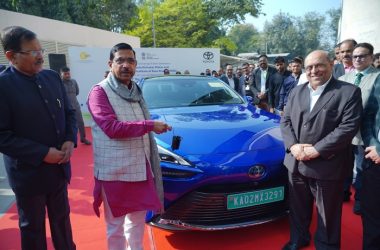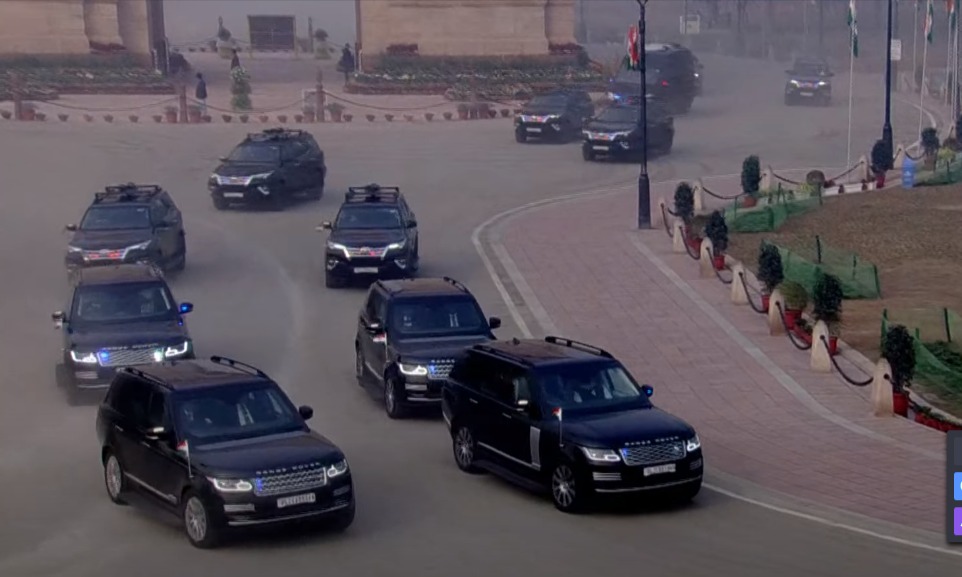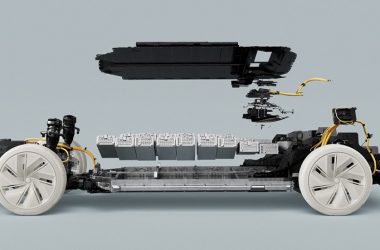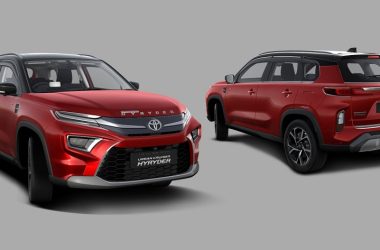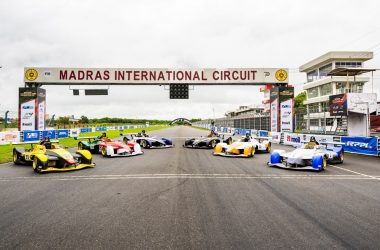New Delhi: The 75th Republic Day Parade in India was a grand spectacle of military might, technological prowess, and national pride. As the nation celebrated its 75th Republic Day, the parade showcased an impressive array of vehicles, aircraft, and military hardware, leaving spectators in awe. Here is a comprehensive list of the remarkable machines that graced the Kartavya Path on this historic occasion:

1. PM Narendra Modi’s Convoy: A Fortress on Wheels
The Prime Minister’s convoy was a sight to behold, featuring a lineup of sleek, all-black vehicles. Leading the pack was the prestigious Range Rover Sentinel, with a staggering price tag of INR 10 crore. This luxurious beast was accompanied by multiple Toyota Fortuners and Mercedes-Benz Sprinter. The convoy boasted over four Range Rovers and more than ten Fortuners, creating an impressive motorcade. Notably, the convoy also included a Fortuner signal jammer, enhancing security measures.
The Range Rover Sentinel, often referred to as a “fortress on wheels,” is equipped with a 5-litre supercharged V8 petrol engine, generating 375 bhp of power. It can accelerate from 0-100 kmph in a mere 10.4 seconds and reach a maximum speed of 193 kmph. Designed by Land Rover’s Special Vehicle Operations division, the 2020 model Sentinel is based on the opulent Autobiography model.
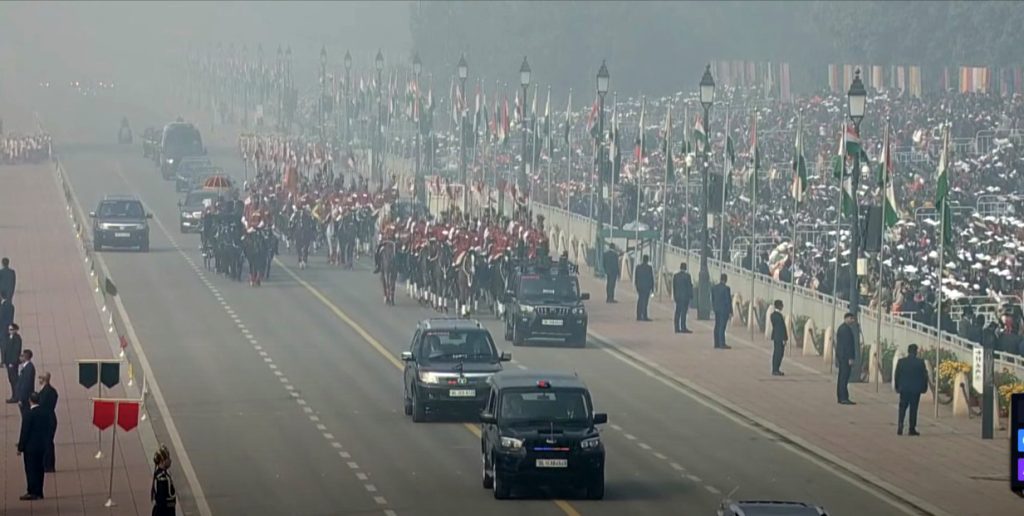
2. President Droupadi Murmu’s Convoy: A Grand Entry with Tradition
President Droupadi Murmu made a grand entrance, eschewing the traditional Mercedes-Benz limousine for a special Presidential horse carriage. This unique choice added a touch of tradition and regality to the parade. Her usual convoy included the opulent Black Mercedes-Benz S600 Pullman Guard armoured limousine, along with Mercedes-Benz S-Class, Sprinter, five Maruti Suzuki Ciaz sedans, over six Tata Safari Storme vehicles, more than five Mahindra Scorpios, and a Tata Winger ambulance.
The Presidential horse carriage, a relic from the past, had not been used in the Republic Day parade for 40 years. It exudes opulence with its gold-plated rims and extraordinary comfort. Originally utilized during the pre-independence era by the British, it later became part of the Rashtrapati Bhavan’s heritage. It served as the ceremonial carriage for the President until 1984 before being discontinued.
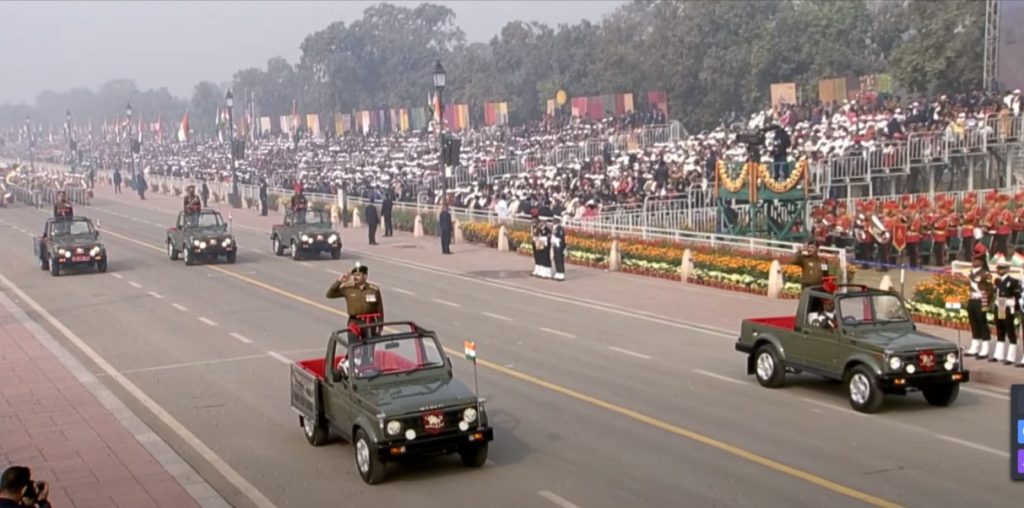
3. Maruti Suzuki Gypsy: The Army’s Signature Vehicle
The Indian Army officers paid tribute to the President with a salute, all while riding in the iconic green convertible Suzuki Gypsy. This vehicle holds a special place in the heart of the Indian Army and is widely used by both the military and police forces across the country. Additionally, it has gained popularity in civilian circles, often seen at rallies and autocross events.

4. Tank T-90 Bhishma: A Force to Be Reckoned With
Led by Lieutenant Fayz Singh Dhillon and bearing the motto ‘Karan Shaurya Vijay,’ the T-90 Bhishma tank showcased its formidable presence. This third-generation Russian main battle tank was designed to replace the aging T-72. It is armed with a 125 mm 2A46 smoothbore main gun, the 1A45T fire-control system, an upgraded engine, and a gunner’s thermal sight, making it a formidable force on the battlefield.
5. Nag Missile System (NAMIS) Carrier: A Deadly Arsenal

Captain Abhay Pandit led the Nag Missile System (NAMIS) Carrier, which boasts the motto ‘Satrah Mech Har Maidan Fateh.’ The Nag missile, known as “Prospina” for its land-attack version, is an Indian third-generation anti-tank guided missile (ATGM) with an operational range of 500 m to 20 km, depending on the variant. The NAMICA (Nag Missile Carrier) is a modified BMP-2 with additional wheels, commonly referred to as “Sarath” in India. Classified as a tank destroyer, it carries a total of 12 missiles, with 6 in ready-to-fire mode and 6 in storage.

6. BMP 2/2K Sarath: An Amphibious Warrior
Led by Lieutenant Shivam Singh, the BMP-2/2K Sarath is an amphibious infantry fighting vehicle introduced in the 1980s, succeeding the BMP-1. Armed with the ability to engage enemies within a 4 km radius, including night operations, the Indian Army’s upgraded BMP-2 Sarath is a versatile combat vehicle. Their motto is ‘Pehla Humesha Pehla’.
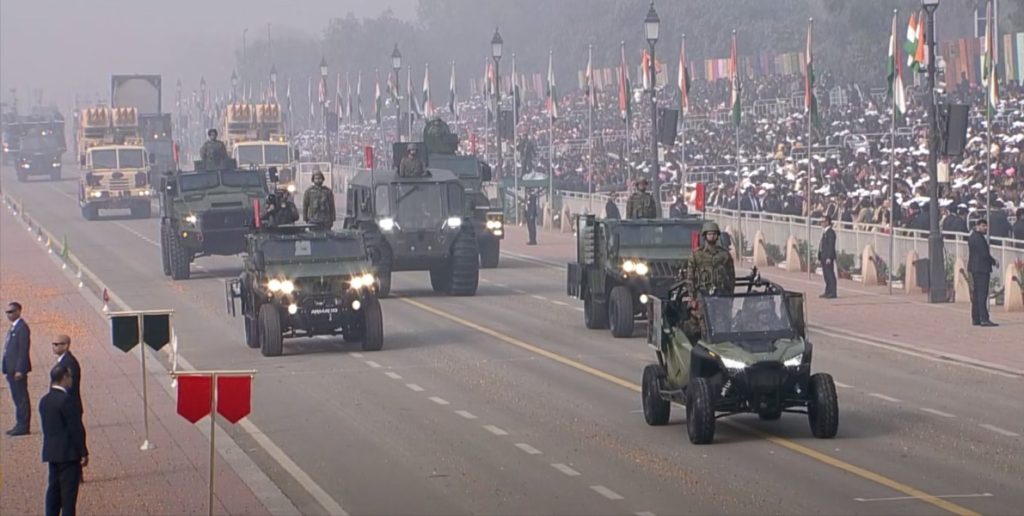
7. All-Terrain Vehicles: Conquerors of Varied Terrains
Led by Major Toofan Singh Chauhan, Lieutenant Colonel Panmei Kabiphun, and Captain Armandeep Singh Aujla, this group showcased six modern specialist vehicles, each tailored for different terrains. From quick reaction force vehicles to heavy and medium variants, light specialist vehicles, vehicles mounted infantry mortar systems, all-terrain vehicles, and specialist mobility vehicles, this array was designed to conquer snowy, desert, and mountainous landscapes. The vehicles included Polaris RZR 1000, 215 BHP Mahindra Armado light armoured personnel carrier, Kalyani M4 armoured troop transporter, Tata QRFV armoured troop transporter and the remarkable Army Sherp SMV N 1200.

8. Army Sherp SMV N 1200: A Master of Terrains
The Army’s specialist mobility vehicle, the Sherp N 1200, priced at INR 1.3 crore, proved its worthiness. This rugged vehicle can navigate through dense forests, fallen trees, shaky grounds, gravel, peat, moor, marsh, dunes, swamps, boulders, scree, snow, and ice with ease. It can float in various water bodies, climb from water onto ice, operate at extreme temperatures ranging from -40°C to +45°C, and overcome obstacles up to 1 meter in height. With its 1794 cc, Inline-3 cylinder engine, 55 HP power, and remarkable capabilities, the Sherp N 1200 is a versatile asset.
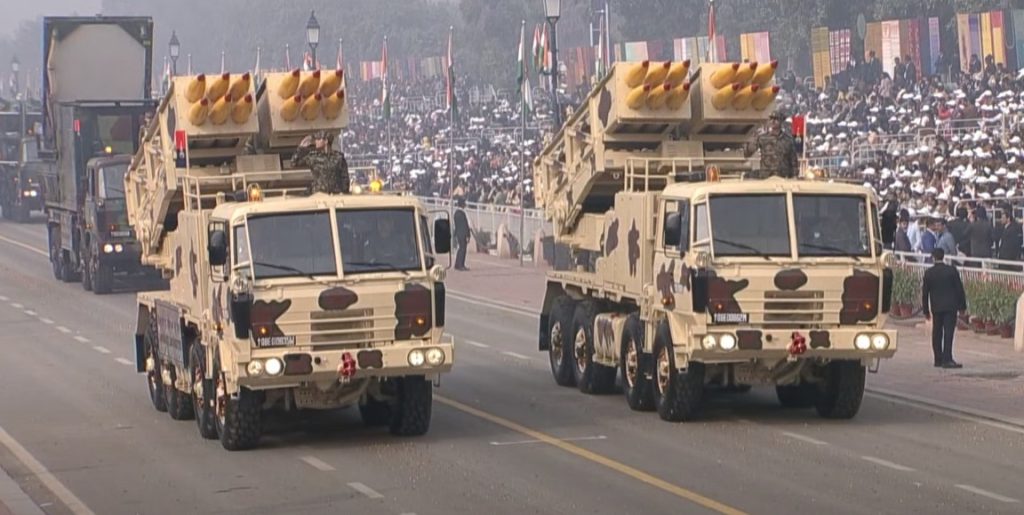
9. Pinaka: The Firepower Unleashed
Lieutenant Priyanka Sevda led the Pinaka, a multiple rocket launcher system produced in India. Developed by the Defence Research and Development Organisation (DRDO) for the Indian Army, Pinaka has a maximum range of 40 km for Mark-I and 60 km for the enhanced Mark-I version. It can fire a salvo of 12 high-explosive rockets in just 44 seconds. Their motto is ‘Sarvatra Izzat ‘O’ Iqbal’.

10. Swathi: The Silent Guardian
Commanded by Lieutenant Deepti Rana, the Swathi weapon locating radar system is a marvel of Indian engineering. This mobile artillery-locating, phased-array radar is designed to detect and track incoming artillery and rocket fire, enabling precise counter-battery fire. Developed jointly by the Electronics and Radar Development Establishment (LRDE) and Bharat Electronics Limited (BEL), Swathi plays a critical role in India’s defense.

11. Sarvatra Mobile Bridging System: Crossing Boundaries with Ease
Under the command of Captain Suman Singh, the Sarvatra Mobile Bridging System showcased its capabilities. This 75-meter, multi-span, mobile bridging system features five scissor bridges made of aluminum alloy, each with a 15-meter span, mounted on separate mobile platforms. The system can be deployed and operationalized in less than 2.5 hours, offering a crucial advantage in military operations. The Sarvatra is designed to overcome obstacles and provide mobility support for the Indian Army.
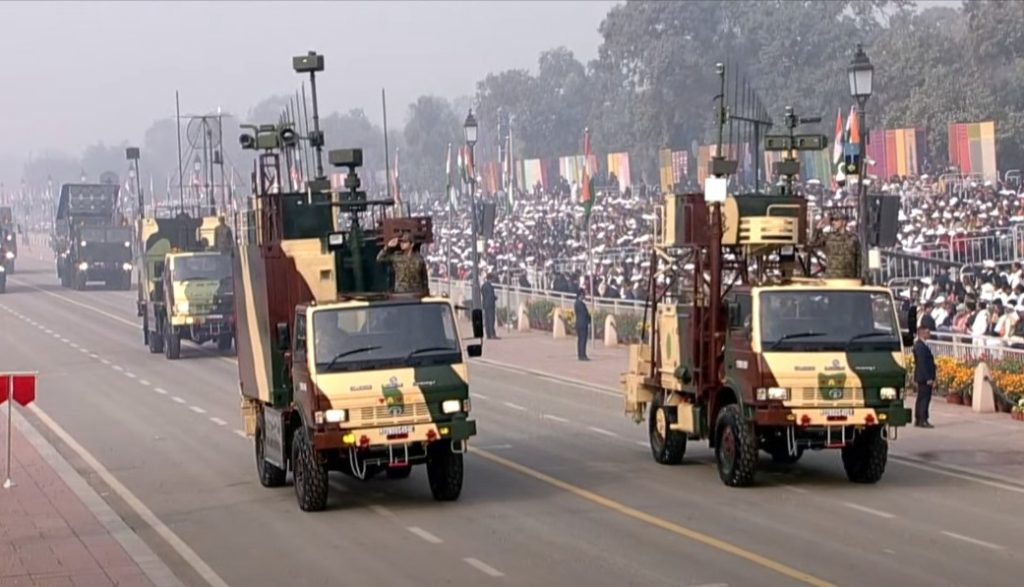
12. Mobile Drone Jammer System: Guardian of the Skies
Led by Lieutenant Colonel Ankita Chauhan, this system is a silent sentinel against aerial threats. The Mobile Drone Jammer System excels in finding, tracking, and neutralizing drone activities and unmanned aerial vehicles. Their motto is ‘Teevra Chaukas’.

13. Advance Radio Frequency Monitoring System: The Silent Watcher
Under the command of Captain Akanksha Gomes, this indigenous system is capable of stopping the enemy’s analogue and digital communication while also monitoring and inspecting it. It is a vital component of electronic warfare.
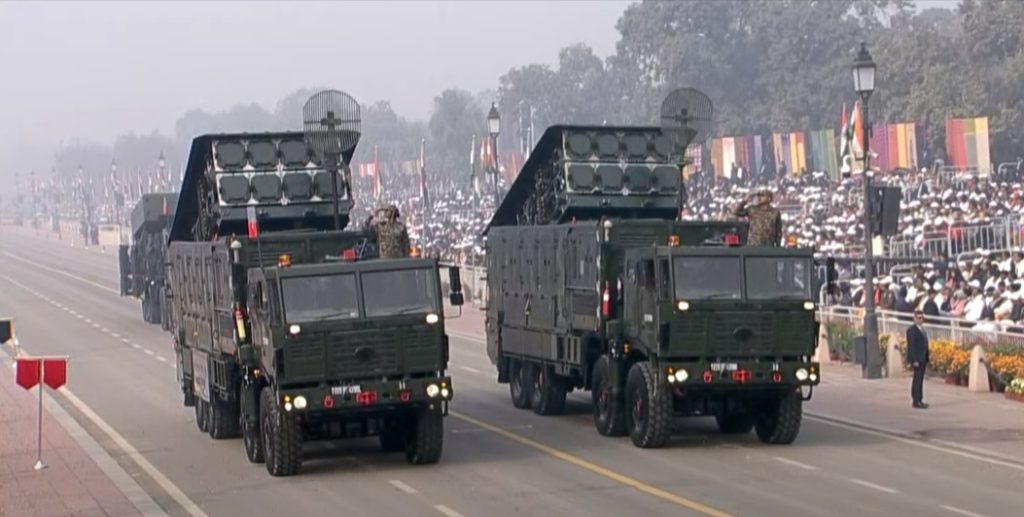
14. Medium Range Surface to Air Missile System (MRSAM): Shielding the Skies
Led by Lieutenant Sumedha Tiwari, the MRSAM is a high-response, quick-reaction, vertically launched supersonic missile. Designed to neutralize enemy aerial threats, including missiles, aircraft, guided bombs, and helicopters, it boasts a range of 70 km. The MRSAM is utilized by the Army, Navy, and Air Force in different variants.

15. Multi-function Radar (MF RDR): Eyes in the Skies
Commanded by Captain Abhijeet Kumar, this Multi-Function Fire Control Radar, with its electronically scanned phased array, serves as the primary sensor at the flight level for Air Defence Weapon Systems. It is capable of extensive search, tracking multiple targets and missiles, and guiding multiple missiles simultaneously. The radar’s flexibility and distributed hardware support various air defense operations. Their motto is ‘Aakashe Shtrun Jahi’.
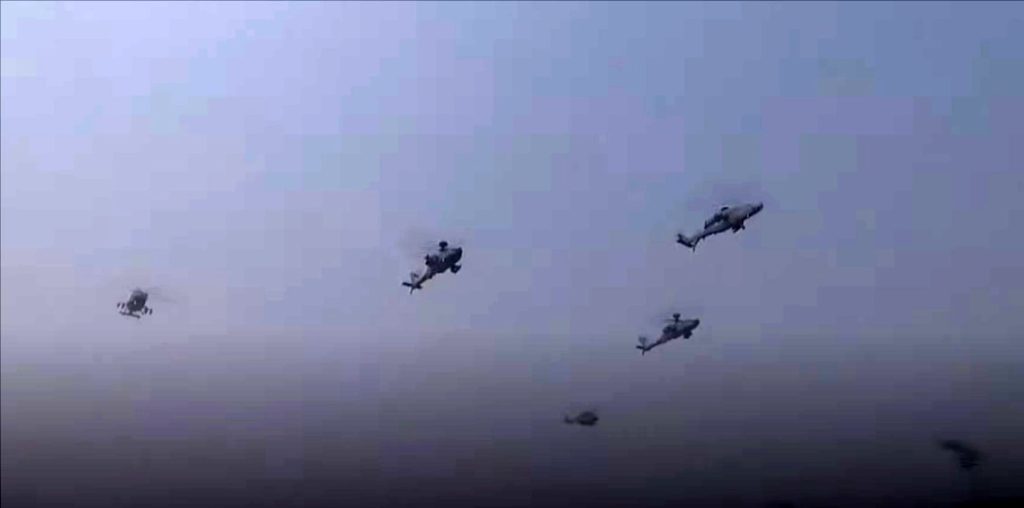
16. Apache AH-64E and HAL Prachand Helicopter: Sky Dominance
In aero formation, Group Captain Deepak Bishnoi, Group Captain Anand Kumar Yadav and Wing Commander Harsheed Habeed, Squadron leader Ragi Ramachandran, Wing Commander Upendra Kumar Mishra and Wing Commander Sushil Khajuria of No. 116 Helicopter Unit (Tankbusters) showcased the Apache AH-64E and HAL Prachand helicopter. The No. 125 Helicopter Squadron (Gladiators) operates the Apache AH-64E, featuring advanced digital connectivity, Joint Tactical Information Distribution System, powerful T700-GE-701D engines, IFR capability, and the ability to control unmanned aerial vehicles (UAVs). The HAL Prachand helicopter boasts the highest flight ceiling among all attack helicopters, making it a formidable force in the sky.
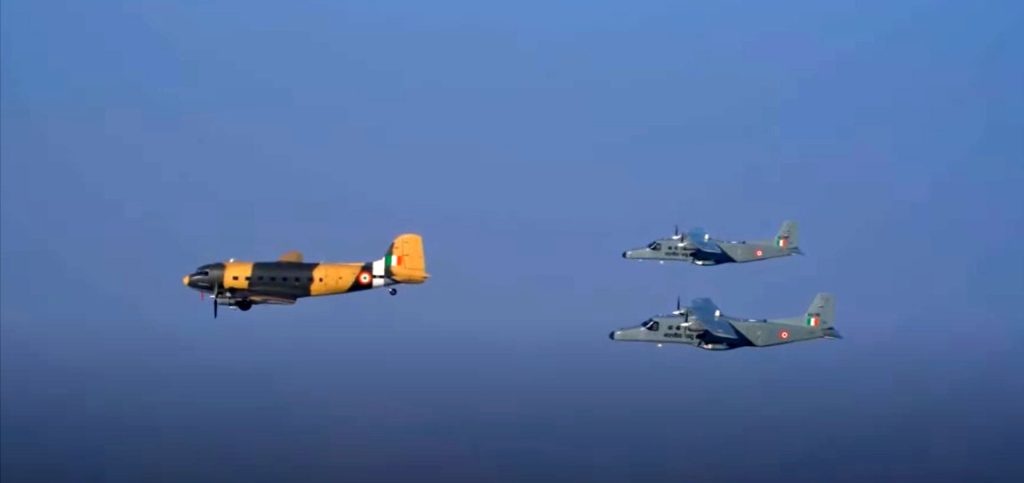
17. Douglas C-47 Skytrain Dakota and Dornier 228 Heritage Fly: A Nostalgic Journey
In a tangail airdrop formation, Wing Commander AK Singh, Wing Commander HD Kala, Wing Commander Shubham Mishra, Flight lieutenant Sai Shraddha, Squadron leader Nikita Malhotra and Flight lieutenant N. Gurunathan from Air Force Heritage and No. 42 Squadron led the Douglas C-47 Skytrain Dakota and Dornier 228 Heritage Fly. The Douglas C-47 Skytrain, a military transport aircraft derived from the civilian Douglas DC-3, participated in the parade, symbolizing its historical significance. The Dornier 228, a twin-turboprop STOL utility aircraft, played a crucial role in fulfilling light transport duties for the Indian Air Force.
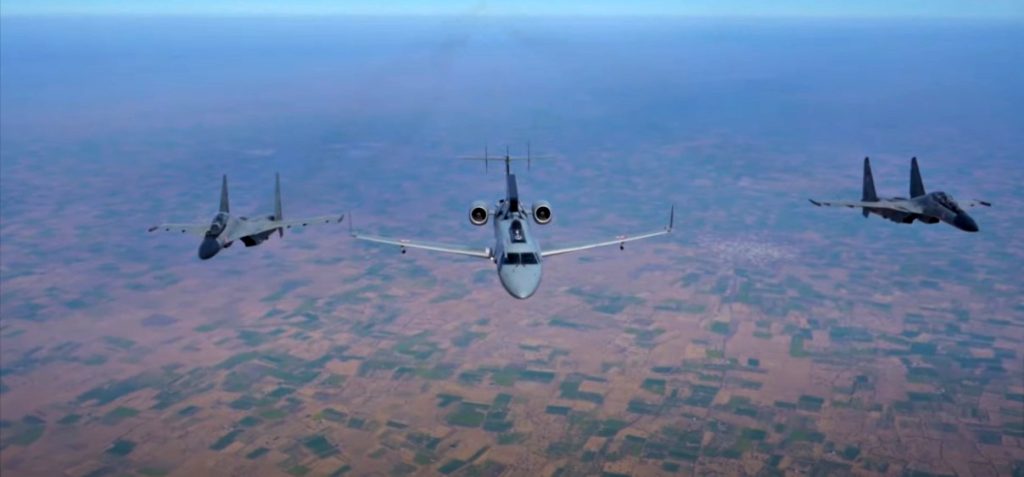
18. C-295 and C-130J: Tactical Transport Masters
In an arjan formation, Group Captain Prashant Singh Negi, Wing Commander Vikram Seth, Group Captain Ankit Raj Singh, Squadron leader Sparsh Ahlawat, Wing Commander Manish Vyas and Squadron leader KV Prasad from 77th Squadron led the C-295 and C-130J aircraft. The CASA C-295, now Airbus C295, served as a medium tactical transport aircraft, originally designed and manufactured by CASA. The Lockheed Martin C-130J Super Hercules, a four-engine turboprop military transport aircraft, exemplified its capabilities with its impressive flight performance.
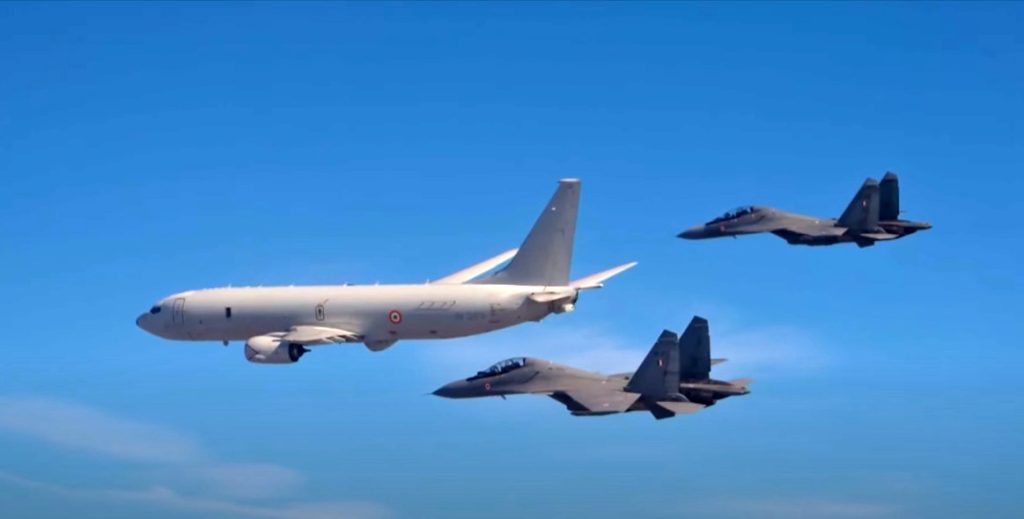
19. Netra Embraer ERJ 145I and Sukhoi Su-30MKI: Guardians of the Skies
In vic formation, Group Captain S. Gunasekaran, Group Captain Uttar Kumar, and Wing Commander Manish Jakhar displayed the Netra Embraer ERJ 145I and Sukhoi Su-30MKI. The Netra Embraer ERJ 145I, with its airborne early warning and control capabilities, is a key asset for detecting and tracking potential threats. The Sukhoi Su-30MKI, a twin-seat, twinjet multirole air superiority fighter, demonstrated its agility and combat prowess.
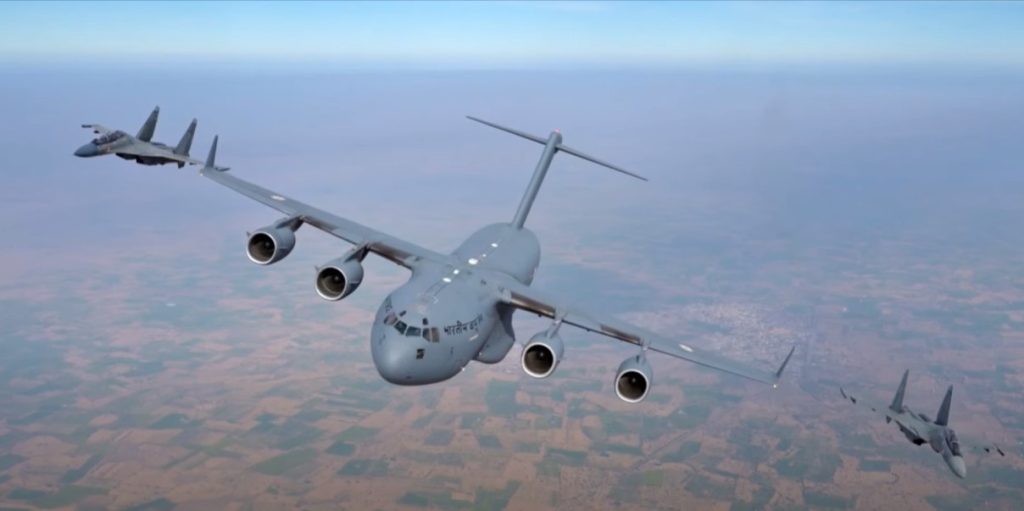
20. Indian Navy P-8i and Sukhoi Su-30: Maritime Supremacy
In varuna formation, Commander Ruchit Gaur, Group Captain Manoj Yadav, and Wing Commander Parvindar Singh Chahal from No. 31 Squadron led the Indian Navy P-8i and Sukhoi Su-30. The Boeing P-8 Poseidon, a maritime patrol and reconnaissance aircraft, plays a vital role in safeguarding India’s maritime interests. The Sukhoi Su-30, a formidable air superiority fighter, further reinforced India’s air capabilities.
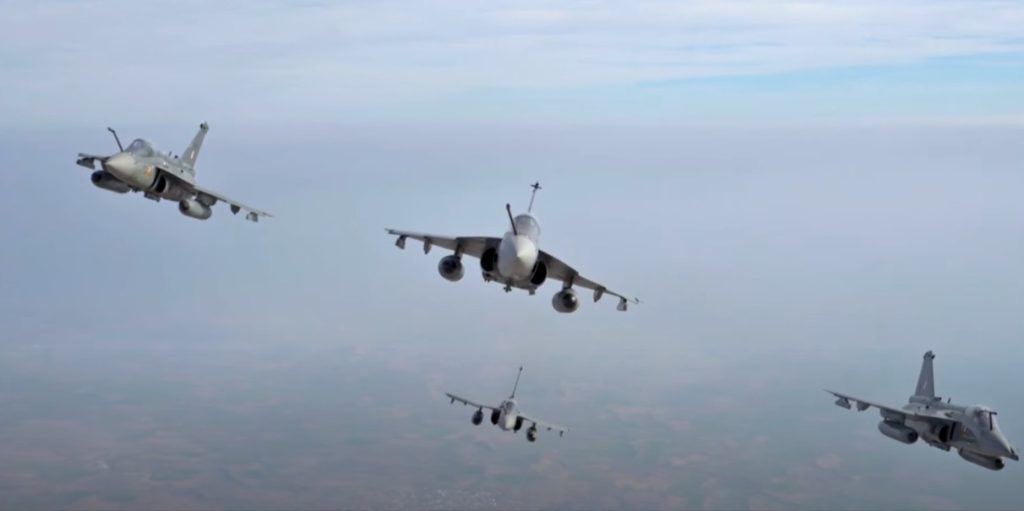
21. Boeing C-17 and Sukhoi Su-30: Airborne Excellence
In bheem formation, Group Captain Sameep Nijhawan, Squadron Leader Amit Kumar Yadav, and Wing Commander Akshay Arun Mahale showcased the Boeing C-17 and Sukhoi Su-30 aircraft. The Boeing C-17 Globemaster III, a large military transport aircraft, fulfills India’s very heavy lift transport requirements. The Sukhoi Su-30, a twin-engine, two-seat supermaneuverable fighter aircraft, displayed its versatility and combat capabilities.

22. Six SEPECAT Jaguar (Shamsher): Ground Attack Force
In amrit formation, Group Captain Nagendra Abhishek, Wing Commander Manorath Sabharwal, Wing Commander Vishwanathan Naga, Wing Commander Jai Krishnan, Squadron Leader Akash Karpe and Wing Commander Chakrapani Kajla from No. 14 (Bulls) and No. 5 (Tuskers) Squadron IAF showcased the SEPECAT Jaguar, known as “Shamsher” in Indian service. These aircraft, flying at 750 kmph, serve as the primary ground attack force for the Indian Air Force, with 139 Jaguars currently in operation.
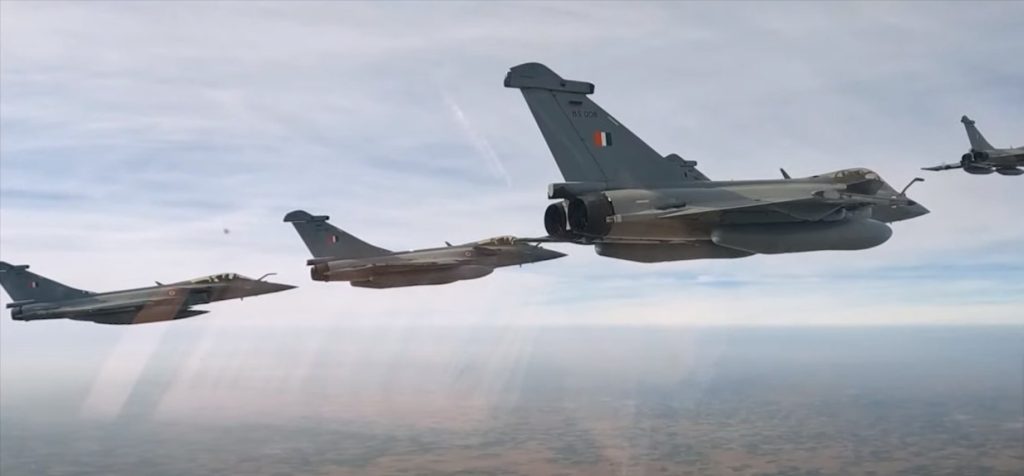
23. Six Dassault Rafale: A Display of Aerial Dominance
In bajrang formation, Group Captain Abhishek Tripathi, Wing Commander Chaitanya Suryavanshi, Squadron Leader Yash Sawalkar, Wing Commander Amit Verma, Squadron leader Sushil Shinde and Squadron leader Vijay Chandgude from No. 101 Squadron (Falcons) flew six Dassault Rafale aircraft. These 4.5th generation fighters demonstrated their prowess with precision. As of June 2022, India operates 36 Rafale fighters, equipped with a wide range of weapons for air supremacy, interdiction, reconnaissance, ground support, in-depth strike, anti-ship strike, and nuclear deterrence missions.
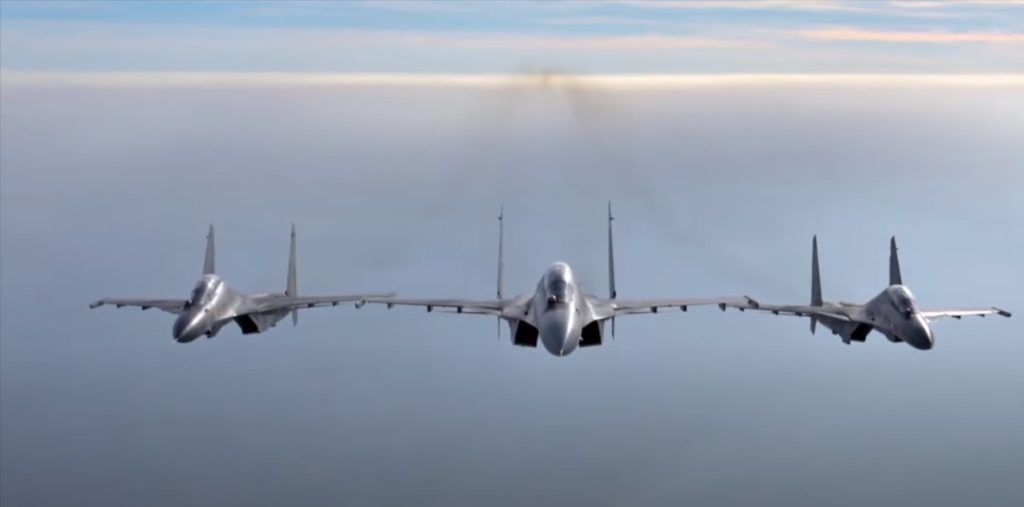
24. Three Sukhoi Su-30MKI: Masters of the Skies
In trishul formation at 900 kmph, Group Captain Sachin Arora, Group Captain Omar Browne, and Wing Commander Navjot Singh showcased the Sukhoi Su-30MKI, a twin-seat, twinjet multirole air superiority fighter known for its supermaneuverability and combat capabilities.
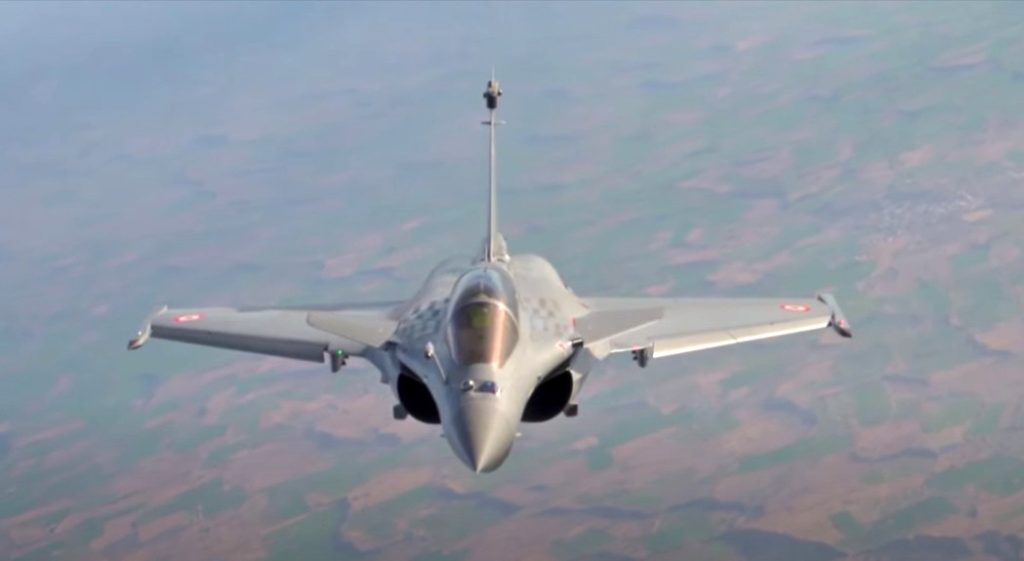
25. Dassault Rafale’s Spectacular Aerial Maneuver
In a spectacular display of precision and power, the Dassault Rafale, a multi-role fighter aircraft, took center stage. Piloted by Group Captain Arun Kumar and co-piloted by Squadron Leader Shivangi Singh from No. 17 Squadron, famously known as the “Golden Arrows,” the Rafale exhibited its incredible capabilities. The highlight of the Rafale’s performance was the “Vijay Maneuver,” also known as the “Vertical Charlie.” This aerobatic maneuver involves the aircraft pulling up vertically into the sky and executing a series of rolls in this attitude before gracefully returning to a normal flying position. The maneuver is often executed with precision following a low pass, thrilling the audience with its combination of power and grace. The Rafale’s performance left the spectators in awe, showcasing not only the technical superiority of the aircraft but also the exceptional skill and training of the Indian Air Force pilots.
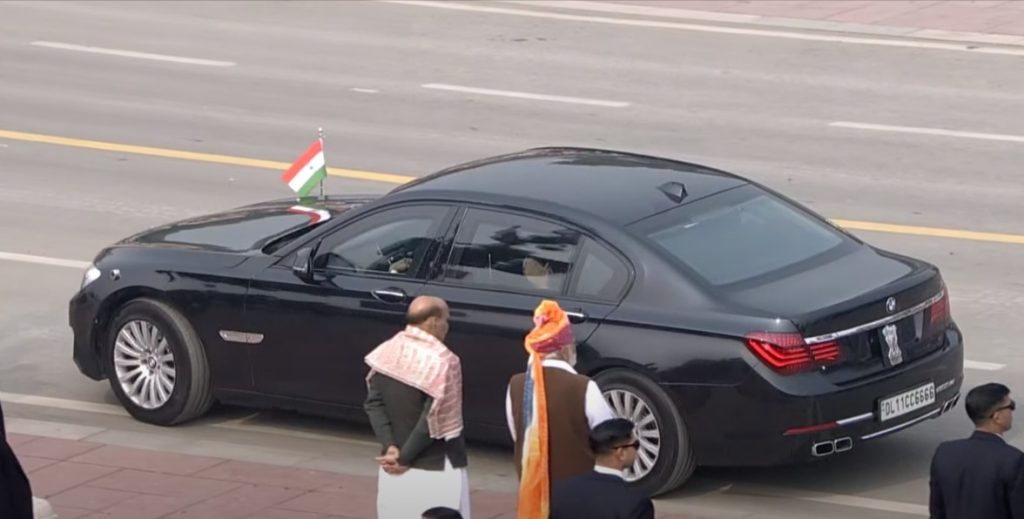
26. Vice President’s Arrival in Style: BMW 7 Series High Security
Adding an element of luxury and sophistication to the event was the arrival of the Indian Vice President, Jagdeep Dhankhar, in a black fifth-generation 2016 BMW 7 Series 760 Li High Security (F01). This remarkable automobile was adorned with the VIP registration number DL11 CC 6666, signifying the importance of the occasion.
The BMW 7 Series is renowned for its elegant presence, which is complemented by its exceptional engineering, superior comfort, unbeatable performance, and top-notch safety features. What makes this choice even more impressive is the car’s commitment to sustainability. The BMW 7 Series incorporates BMW EfficientDynamics technologies, making it an environmentally-friendly choice. It’s worth noting that BMW has been recognized as the world’s most sustainable car company for five consecutive years by the Dow Jones Sustainability Index. The Vice President’s arrival in the BMW 7 Series added an air of opulence to the event, symbolizing a blend of modernity, luxury, and eco-consciousness.
The 75th Republic Day Parade was a remarkable spectacle that celebrated India’s strength, diversity, and technological prowess. From formidable military hardware to elegant presidential carriages, the event showcased the nation’s pride and resolve.
As the parade drew to a close, it left spectators with a sense of awe and admiration for the incredible machines that make India’s defense and security forces among the finest in the world.
